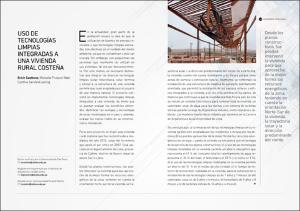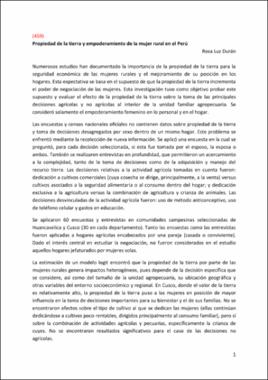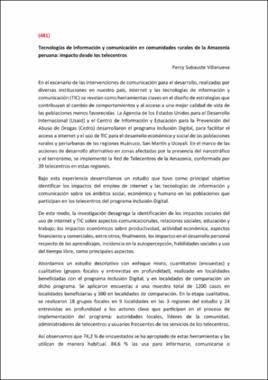Mostrar el registro sencillo del ítem
Uso de tecnologías limpias integradas en una vivienda rural costeña
| dc.contributor.author | Prutschi Weil, Michelle | |
| dc.contributor.author | Seinfeld Lemlig, Cynthia | |
| dc.contributor.author | Saettone Olschewski, Erich Arturo | |
| dc.contributor.other | Prutschi Weil, Michelle | |
| dc.contributor.other | Seinfeld Lemlig, Cynthia | |
| dc.contributor.other | Saettone Olschewski, Erich Arturo | |
| dc.date.accessioned | 2018-01-27T16:24:44Z | |
| dc.date.available | 2018-01-27T16:24:44Z | |
| dc.date.issued | 2017 | |
| dc.identifier.citation | Prutschi-Weil, M., Seinfeld-Lemlig, C., & Saettone-Olschewski, E. (2017). Uso de tecnologías limpias integradas en una vivienda rural costeña. Limaq, (003), 145-158. doi:http://dx.doi.org/10.26439/limaq2017.n003.1786 | es_ES |
| dc.identifier.issn | 2410-6127 | |
| dc.identifier.uri | https://hdl.handle.net/20.500.12724/5576 | |
| dc.description.abstract | Este proyecto permite que Lucy, quien pierde su casa en el terremoto, pueda tener un nuevo hogar. La casa recoge las memorias familiares, así como el modo de vida de los habitantes costeros en donde interior y exterior se confunden a través del uso de patios y alares, que permiten sobrellevar las inclemencias del clima y posibilitan las relaciones espaciales, pero también las humanas. La vivienda está ubicada en Nuevo Imperial, una zona rural costera, y aprovecha la energía solar y eólica de la zona incorporando en su diseño técnico y arquitectónico energías renovables: paneles solares para alimentar bombillas LED, un calentador solar para usar agua caliente sin consumir energía y turbinas eólicas para recargar equipos celulares y computadoras. Se usaron materiales como caña para las celosías en muros y techos, que otorgan la transparencia pero también dan sombra, así como muros de ladrillo frotachado, que permiten percibir el transcurso pausado del día, sin sombras. | es_ES |
| dc.description.abstract | This project provides a new home for Lucy, who lost hers during the earthquake. The house collects the family memories, as well as the life style of people living in the coast, where interior and exterior are mixed up by the use of courtyards and eaves which let the family bear the harshness of the weather, where not only spatial relations but also human relationships happen. The house is located in Nuevo Imperial — a rural area in the coast. Its technical and architectural design includes renewable energy taking advantage of the solar and wind energy present in the area: solar panels for LED light bulbs, a solar water heater to avoid the use of energy, and wind turbines to charge cellphones and computers. The use of materials such as cane for wall and roof latticing, allow both transparency and shadow to get into the house. Its plastered brick walls let the users see how the days pass with pauses, without shadows. | |
| dc.format | application/pdf | |
| dc.language.iso | spa | es_ES |
| dc.publisher | Universidad de Lima | es_ES |
| dc.relation.uri | https://revistas.ulima.edu.pe/index.php/Limaq/article/view/1786/1794 | |
| dc.rights | info:eu-repo/semantics/openAccess | |
| dc.rights | https://creativecommons.org/licenses/by/4.0/ | |
| dc.source | Universidad de Lima | |
| dc.source | Repositorio Institucional - Ulima | |
| dc.subject | Vivienda rural | es |
| dc.subject | Zonas rurales | es |
| dc.subject | Costas | es |
| dc.subject | Energía solar | es |
| dc.subject | Energía eólica | es |
| dc.subject | Housing, rural | en |
| dc.subject | Rural areas | en |
| dc.subject | Coasts | en |
| dc.subject | Solar energy | en |
| dc.subject | Wind power | en |
| dc.subject.classification | Arquitectura y urbanismo / Proyectos arquitectónicos | es |
| dc.title | Uso de tecnologías limpias integradas en una vivienda rural costeña | es_ES |
| dc.title.alternative | Use of Clean Technologies into a Coastal Rural Home | es_ES |
| dc.type.other | Artículo | |
| dc.identifier.journal | Limaq | |
| dc.publisher.country | Perú |
Ficheros en el ítem
| Ficheros | Tamaño | Formato | Ver |
|---|---|---|---|
|
No hay ficheros asociados a este ítem. |
|||
Este ítem aparece en la(s) siguiente(s) colección(ones)
-
Limaq [51]



